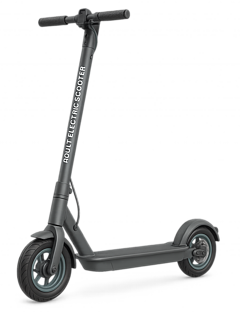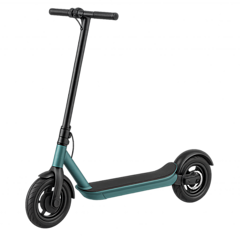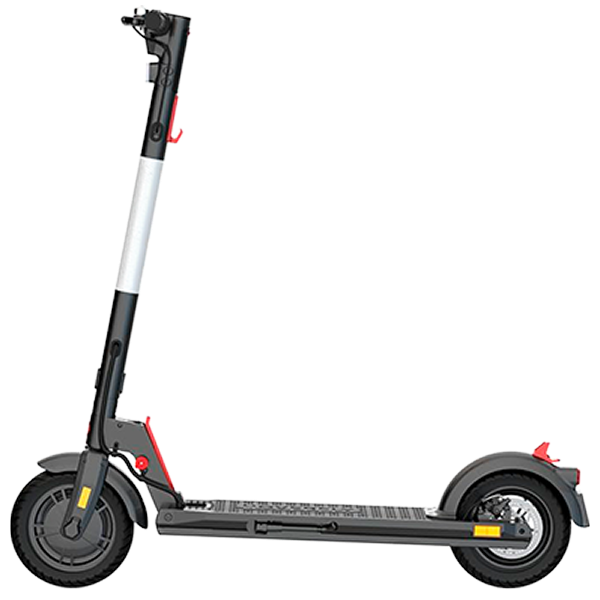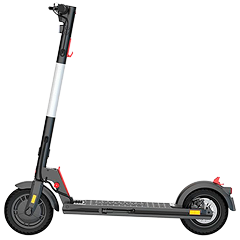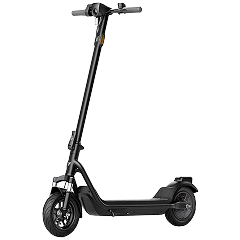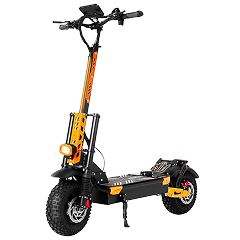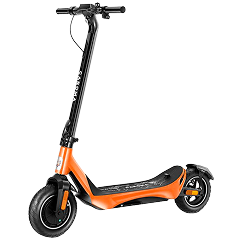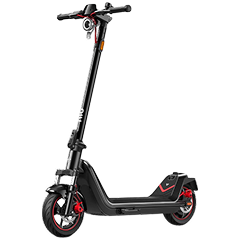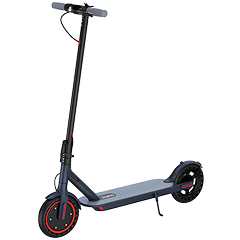Off-roading on an electric scooter might sound a bit crazy at first. Traditionally, e-scooters were built for smooth pavement with small wheels, minimal suspension, and upright riding posture, which is not exactly a recipe for trail riding.
But throw on some bigger wheels, add proper suspension, and upgrade to a beefier motor and battery, and you’ve got yourself a scooter that can handle the dirt, bumps, and hills on off-road adventures. In other words, it is possible to have fun off the beaten path on a scooter, as long as you pick the right one.
This guide will walk you through what to look for in an off-road electric scooter, so you know what to expect and how to evaluate the key features that matter.
What Makes an Electric Scooter Good for Off-Roading?
Let’s break down the most important features you need to look out for.
IP Rating (Water & Dust Protection)
When you’re riding trails, your scooter is going to face dirt, dust, mud, and water. If water or fine dust works its way into the electronics, you could quickly end up with a dead scooter. That’s why a high Ingress Protection (IP) rating is essential for off-road use.
The IP rating is a standardized way to describe how well the scooter is sealed against solids and liquids. The first digit (0-6) is dust protection, and the second (0-9) is water protection. For example, a scooter rated IP54 can handle dusty trails and light rain suitable for “occasional off-roading” conditions, while IP65 or above indicates a more rugged “all-terrain” readiness with protection against heavy rain and splashes.
In general, most e-scooters tolerate a bit of road dust even without a formal rating, but off-road riding kicks up lots of debris and water, so look for a high IP rating. At the very least, go for IP54 protection, or if you’re really stuck, something that’s water resistant IPX4.
Along with internal sealing, good fender protection front and rear is vital to keep mud and gunk from splattering all over you (and into the scooter’s crevices) when you ride through a puddle or wet grass.
Get a scooter with a high IP rating, at least water-resistant IPX4 or above, and preferably dust-protected too (IP54 minimum).
Suspension — The Make or Break Feature
Suspension is arguably the most crucial feature for off-roading (right up there with tire size). Even the best tires in the world can’t make up for zero suspension when you’re riding over uneven terrain. A quality suspension soaks up bumps, keeping your wheels in contact with the ground and giving you control. Generally, the better the suspension, the higher the price tag, but it’s worth it if you plan to do a lot of trail riding.
There are several types of suspension systems and configurations you’ll come across on electric scooters:
Coil Spring Suspension
Metal springs handle the basics here. Hit a bump, the coil compresses and stores that energy, then pushes back to return to its position. Physics doesn’t get much simpler than this, which keeps manufacturing costs low and maintenance practically nonexistent.
You’ll find these on everything from budget models up to some off-road models (the difference is usually in the size, quantity, and quality of the springs). Budget scooters might throw in a single front spring that barely qualifies as suspension, while Mid-range models add a second spring at the rear, which improves the shock absorption.
Overall, well-executed coil springs still provide decent shock absorption and are low maintenance. However, without any damping, they can rebound quickly, sometimes making your scooter feel like a pogo stick on rough bumps.
Coilover (Undamped Spring Shock)
On some mid-range off-road scooters, you’ll see what looks like a proper motorcycle shock-coil spring wrapped around a tube. But most of them have no actual oil or damping inside. It’s basically just a spring suspension in a different package.
They might give you a bit more travel or better support than a bare spring, but you’re still going to get that quick rebound bouncing (pogo-stick effect). Some have spring preload adjustment which helps you set the spring’s initial stiffness and how far the scooter sinks under your weight. But that doesn’t change rebound speed or compression damping at all.
Elastomer (Rubber) Suspension
Some scooters use dense rubber or polyurethane blocks instead of metal springs. The rubber flexes to absorb shocks. Not very common, but you do see them on a few models (both entry-level and high-end); the execution and quality vary.
They’re extremely low maintenance, lightweight, and you can adjust the feel by swapping in different hardness rubber.
The downside is that rubber has limited travel and tends to feel firmer. Big impacts can overwhelm a rubber suspension more easily than a long spring would. Also, rubber can get stiff in cold weather and might crack over time, so the whole block needs replacing eventually. And finding the right replacement can be an absolute nightmare. In practice, they take the edge off small bumps but won’t cushion big drops nearly as well as a proper shock.
Hydraulic or Air Shocks
This is the gold standard and what you’ll find on high-end performance scooters. Hydraulic shocks (often in a coil-over hydraulic design) use a combination of a spring and oil-filled damper. The spring (or sometimes air pressure in an air shock) handles the bump, and the oil slows down the rebound and compression. The result is a much smoother, controlled ride without all that excessive bouncing.
Many of these are adjustable too. You can dial in the rebound speed, compression stiffness, or air pressure to suit your weight and riding style. Compression damping lets you set how easily the shock compresses (soft for comfort or firm for aggressive riding). Rebound controls how fast it extends again; too fast and you’re back to pogo-ing, too slow and it can’t recover before the next hit.
Air shocks are a variant that use compressed air as the spring medium instead of a coil. They have this progressive feel where they get stiffer through the travel which is perfect for soaking up small bumps while still resisting bottom-out on big hits. They are also fully tunable by adding or removing air with a shock pump.
The downside is complexity and cost. These systems are expensive, add weight, and have more moving parts that might need maintenance like oil changes or seal replacements after long use.
Suspension Layouts
Now, beyond the type of suspension, scooters differ in how it’s all mounted on the frame.
Telescopic Front Fork
Looks like a scaled-down motorcycle fork. Two telescoping legs either side of the front wheel with springs or cartridges inside. Simple, proven design that gives straight up-and-down travel. Many mid-range and premium scooters choose telescopic forks because they offer solid stability and shock absorption in a compact package.
C-Link (Inverted Front Arm)
Instead of a fork, some scooters have a single C-shaped or wishbone-shaped arm that hugs the front wheel and pivots near the scooter’s stem. A short spring or rubber suspension unit connects this arm to the frame. It performs a similar job to a fork by letting the wheel move up and down but with a different approach.
Stem-Internal Spring
On some budget scooters, manufacturers keep costs low by hiding a single spring inside the steering stem/column. When the front wheel hits a bump, the spring in the stem compresses. This setup softens minor jolts and keeps the front end design very slim (since there are no external suspension arms).
However, the travel is usually very limited – it’s only effective for small bumps. You won’t find this on serious off-road scooters, because it can’t handle big impacts well, but it’s worth mentioning.
Swingarm
The majority of off-road electric scooters use a swingarm design. This means the wheel is mounted on a lever or arm that pivots at the frame. A shock (spring, rubber, or hydraulic) connects the other end of the arm to the deck or frame.
When you hit a bump with the rear wheel, the swingarm moves up, and the shock absorbs the impact. There are single-sided swingarms and dual-sided swingarms, but the principle is the same. Swingarms allow for longer suspension travel in the rear and are great for soaking up big bumps.
Seatpost Suspension
For scooters with seats, sometimes the seat itself is on a suspension post. The spring-loaded or air post absorbs shocks before they reach you. Nice add-on for comfort if you prefer sitting.
For proper off-roading, dual suspension is non-negotiable. If budget allows, go for high-end adjustable shocks, ideally coil-over hydraulic or air, as they offer the best cushioning and control. And finally, adjustable beats fixed every time because you can tune it for your weight and riding style
Tire Size — Bigger is Better Off-Road
So when it comes to wheels for off-roading, bigger is absolutely better. The reason is dead simple — larger wheels just roll over obstacles way more easily.
Think about it this way. A 6-inch pothole that would completely swallow a tiny skateboard wheel is barely even a bump to a proper mountain bike tire. The same principle applies to scooters. Greater wheel diameter basically decreases the angle at which any given bump hits the wheel, allowing it to “roll over” rather than getting stuck. In practical terms, a scooter with 10 or 11-inch tires will handle ruts, roots, and potholes far more gracefully than one with 6-8 inch wheels. Plus you get added stability and a much smoother ride. You’ll feel way less of each bump, and the scooter won’t try to pitch you forward every time the front wheel hits a rock.
For proper off-road capability, 10 inches is the absolute minimum, but 11 inches or larger is where things get really good. That extra inch of radius means obstacles need to be 2 inches taller to cause you the same problems.
Width matters too. A wider tire, say 3+ inches wide, gives you more surface area touching the ground, which improves traction and helps float over soft surfaces like loose dirt or sand. Wider tires also add some suspension effect by distributing impact and pressure. The downside to big wheels and tires is extra weight and a bit more drag (and they can make the scooter less nimble in tight turns), but off-road riding prioritizes stability over razor-sharp agility.
Tire Type
Pneumatic vs. Solid Tires
Unless you’ve got suspension nicked from a superbike, pneumatic tires are absolutely essential for off-road riding. They’re basically part of your suspension system, soaking up all those tiny vibrations and small impacts that your shocks miss. They also give you way better grip because they can actually conform to the terrain by flexing and keeping a larger contact patch. Solid tires just skip over bumps and have poor traction on uneven surfaces.
Solid tires made of rubber or foam won’t go flat, that’s true. But they provide almost no give whatsoever (unless it has a honeycomb design). On rough terrain, solid tires will make your scooter feel absolutely skittish and harsh. Every single bump goes straight through to you.
However, going off-road also raises the risk of flats. Sharp rocks, thorns, nails, all sorts of nasty stuff can puncture tires. Tubed pneumatic tires are the worst for this. Get a thorn through the tire, and you’re looking at removing the wheel, splitting the tire, patching or replacing the tube, then putting it all back together. Proper nightmare.
Tubeless pneumatics solve this brilliantly though. In the case of a puncture just ram a rubber plug in the hole with a simple tool, pump it back up, keep riding. Takes two minutes instead of twenty.
Tubeless tires also lose air way slower when punctured. Sometimes you can ride back home before you even need to properly repair it. You can also use tire sealants inside the tire for extra puncture protection, as they automatically seal small holes.
Tread Pattern (Street vs. Off-Road)
The tire’s tread makes a massive difference in how it handles different surfaces.
Street tires are usually slick or have shallow, straight grooves. Great for asphalt because they’ve got more rubber touching smooth ground. But on loose dirt or gravel, street slicks will just slip all over the place because they can’t “bite” into the surface.
For off-road, you want knobby or all-terrain tread, the kind of chunky, deep patterns you see on dirt bikes or mountain bike tires. These have deeper lugs and patterns that can dig into softer terrain, providing much-needed traction on dirt and gravel.
The trade-off is a bit more road noise and slightly less efficiency on pavement. Off-road tires might wear faster too if you do loads of street riding, since the soft rubber and big lugs are designed for dirt, not hard pavement. But that’s a small price to pay for the added control and safety off-road.
What to Choose: Pneumatic + Tubeless + Knobby
Deck Clearance (Ground Clearance)
Nobody talks about this enough, but ground clearance can make or break your off-road experience. That measurement from the bottom of your deck to the ground determines what obstacles you can clear versus what’ll stop you dead.
For context, most commuter scooters sit 3-4 inches off the ground. Fine for smooth roads and the occasional speed bump. Take that off-road and you’ll be grinding the underside on every rock, root, and rut. Remember, that’s where your battery pack, controller, and main wiring lives. Scraping them repeatedly is asking for expensive problems.
For proper off-road use, 5 inches is the bare minimum, but 6-8 inches is the sweet spot. This gives you room to tackle proper obstacles without constantly worrying about damage. Higher clearance also means better approach and departure angles, meaning you can tackle steeper obstacles without the front or rear catching.
Keep in mind, higher clearance can mean a higher center of gravity, but off-road scooters are usually designed with wide decks and stable geometry to compensate.
What to Choose: Look for proper ground clearance, roughly 5-6 inches minimum, with 6+ inches if you’re doing serious off-roading.
Handling and Control (Frame & Rider Interface)
Off-road riding demands way more from your scooter’s handling than city commuting. Here we consider a few aspects:
Handlebar Width & Height
Most electric scooters have narrow bars, maybe 18-23 inches wide, so they can squeeze through traffic and fold down nicely. But for off-road stability, wider bars are absolutely better. Wider handlebars, say 24-27 inches or above, give you loads more leverage to steer, especially at speed or when you’re dodging bumps. With wide bars, you can make fine adjustments to balance and direction with way less effort, and you’re much less likely to overcorrect.
Many off-road scooters come with nice wide bars by default, but if not, you can often swap the handlebar for an aftermarket one that’s wider. Just make sure it’s compatible with your stem clamp.
Height-wise, the bars should be at a comfortable level, around your waist or hips when you’re standing on the deck. You want a relaxed upright posture so you can bend your knees and shift weight easily when riding off-road. If the bars are too low, you’ll be hunching over, which is terrible for your back and balance. Too high and you’re reaching up, equally bad for control.
Most performance scooters have fairly tall stems that should suit the average adult, but really tall riders might need an accessory to raise the bars. Unfortunately, few scooters have properly adjustable-height handlebars, so you pretty much get what you get.
What to Choose: Go for wide handlebars, around 24 inches or more, for better stability and leverage off-road. Bars should be tall enough so you can stand comfortably without hunching.
Deck (Size and Grip)
Off-road riding gets properly bumpy, which means your feet need a decent platform to stand on. A large, stable deck is a massive plus. You want plenty of room to adjust your footing as you handle the terrain. Sometimes you might stand with feet side by side, other times you might stagger your stance or shift weight backwards when going over an obstacle. A cramped deck makes these adjustments difficult and can throw off your balance completely.
Look for a deck that’s wide and long enough to comfortably fit your feet. As a rough guide, something around 20 inches in length and 8 inches in width or larger gives you a nice stable base for most riders. Some off-road models have extended or even two-tier decks to give you extra space.
Just as important is the deck surface. Off-road, things get dusty, muddy, and rough. You absolutely do not want your shoes slipping about. Most scooters have grip tape like a skateboard or rubberized mats on the deck for traction. Make sure whatever it is, it’s high-traction and covers a good area of the deck. If it’s just bare metal or hard plastic, your footing won’t be secure, especially when wet. Thankfully, most performance scooters have some kind of grippy covering, but if not, you can always stick on some aftermarket grip tape.
Another feature to look for is a kickplate or raised footrest at the back of the deck. This is a small upward-angled platform at the rear where you can rest your back foot. Lets you lean back into acceleration and keeps you more planted during uphill climbs or when hitting bumps at speed. A kickplate basically gives you another point of contact with the scooter and makes it way easier to shift your weight back, which is a common technique in off-road riding to unload the front wheel over obstacles. Not all scooters have it, but it’s a really nice addition for off-roading.
What to Choose: Spacious deck, around 20×8 inches or more, with a proper non-slip surface. Bonus points if it’s got a rear kickplate for extra leverage and stability.
Stem (Strength and Stability)
When you’re riding off-road, loads of stress and vibration goes through the stem, so you want something sturdy and wobble-free with a reliable locking mechanism.
Many electric scooters have folding stems for portability, but those can sometimes introduce flex or wobble. Off-road models often prioritize strength over ultra-portability with thicker stem tubing, reinforced collars, and even secondary locking pins or clamps to make sure the stem doesn’t buckle on a hard landing.
One clever safety feature you’ll see on some rugged scooters is a secondary locking pin or latch on the stem. Basically, on top of the main clamp that holds the stem up, there’s a backup pin you can insert once the stem is upright. This makes sure the stem cannot fold down accidentally even if the main latch somehow loosens. Really valuable because, believe it or not, I’ve seen way too many stories of main latches failing or stems breaking mid-ride and causing crashes.
Since stem issues often only show up after hard use, your best bet is to read reviews or rider forums to see if anyone reports stem wobble issues on whatever model you’re considering. In general, check for any movement when you grab the bars and try to twist or rock them. Listen for clicks, creaks, or grinding sounds.
What to Choose: Make sure you’ve got a sturdy, wobble-free stem with a reliable locking mechanism. Ideally, it should have a backup safety latch or pin for extra security.
Motor Power and Drive Configuration
Many standard commuter scooters have motors in the 250W to 500W range, which is fine for flat city rides at moderate speeds. Off-road scooters though, they usually pack way higher power output and often dual motors.
So why dual motors? First off, on loose terrain, traction is often your limiting factor. With power going to both front and rear wheels, you’re way less likely to spin out. If one wheel slips, the other can still pull you through. Second, for climbing hills or blasting over uneven ground, you’ve basically got twice the torque driving you forward. That said, dual-motor scooters weigh loads more and can absolutely hammer the battery when both motors are engaged.
When it comes to actual power, for proper off-road capability, 1000W per motor is really the sensible minimum. That’s 2000W combined, which sounds absolutely mental but gets eaten up surprisingly quickly by steep climbs and soft terrain. Don’t forget the controller needs to handle this too, a beefy 30A+ controller keeps everything running cool under hard use.
What to Choose: For off-roading, dual motors are highly recommended. Ideally around 1000W or more per motor, so roughly 2000W+ total.
Braking System
Different surfaces mean completely different grip levels. That perfect braking point on tarmac becomes a total guess on gravel, mud, or wet leaves. You need proper stopping power with enough feel to modulate it correctly.
Dual hydraulic disc brakes are absolutely the gold standard. Big rotors with quality calipers give you maximum stopping power with excellent feel through the levers. Mechanical disc brakes, the cable-operated ones, are also fine and can be quite strong. They just need a bit more squeeze and occasional adjustment as the pads wear.
Drum brakes are enclosed and low-maintenance, though they don’t quite match the outright power of a good disc and tend to fade when they get hot. But they are less prone to getting dirty or wet since they’re sealed, which could be a consideration if you’re riding through loads of mud. Some scooters even pair a drum on one wheel with a disc on the other.
Off-road braking technique is completely different too. You’ll lock wheels constantly on loose surfaces. Experienced riders actually use this for control, deliberately locking the rear to slide around corners. Beginners might find this a bit tricky, which is why some high-end scooters include ABS systems that prevent lock-ups. Basic e-scooter ABS can help by rapidly engaging and disengaging the brake to keep the wheel rotating and maintain some traction. But that’s just overkill on an electric scooter.
What to Choose: Look for dual brakes front and rear, preferably disc brakes. And if you can get hydraulic discs, even better.
Build Quality and Durability
Off-road riding is going to be absolutely rough on your scooter. Everything will rattle and jolt constantly, so build quality is a massive deal. And let’s be realistic here, at some point you’re going to drop the thing. I’m not being pessimistic, just honest. Your scooter needs to handle being dropped, bashed into the ground, and generally abused way more than any road scooter ever would.
A proper off-road electric scooter should be built like a tank. That means a sturdy frame made of high-strength materials like aircraft-grade aluminum alloys, steel reinforcements in high-stress areas, all that good stuff. One-piece CNC-machined components beat welded assemblies for strength, though quality welding works fine too. Just have a proper look at the weld quality. Smooth, even beads are good, blobby bird poop welds are bad.
Another decent indicator of durability is the scooter’s weight. Off-road models tend to be heavier because they use thicker components. It’s not the whole story, but at least we’ve got half the equation sorted.
Pay attention to things like the fasteners and joints. Are the stem and handlebars held by robust clamps? Are there secondary safety pins like we talked about earlier? Is the folding mechanism metal-on-metal and properly secured? Any part that moves or folds is a potential weak point if it’s not well-engineered. Off-roading will amplify any tiny fit-and-finish issues.
Avoid scooters with loads of plastic. If plastics are present, they should be easily replaceable wear items, not structural components. Metal or at least very tough polymer is what you want for any structural or exposed elements.
Also consider waterproofing and cable management as part of durability. We already talked about IP ratings. From a build standpoint, that means proper seals and gaskets at cable entry points. Exposed cables should be well-insulated and preferably routed internally or at least clipped snugly along the frame so they don’t snag on branches or get pinched by the suspension travel. If you see a scooter with wires dangling about, imagine those catching on something on the trail. Not good. The more protected and integrated everything is, the better for off-road longevity.
Finally, check the maximum load rating too. A higher load capacity can hint at a sturdier build, though not always. Off-road scooters usually have higher weight limits, some 265 lbs, 300 lbs or more, which suggests stronger construction.
Battery Range
When you’re riding off-road, you’re probably doing it for fun and adventure, not just commuting from A to B. That means you want a scooter with enough battery range to let you actually enjoy your trail ride without constantly worrying about running out of juice miles from home.
Off-road riding can actually consume battery way faster than city riding. Hills, lower speeds in rough terrain, and constant acceleration and braking all hammer the battery. So having a healthy margin of range is absolutely wise.
Many off-road capable scooters come with fairly large battery packs. It’s common to see 20+ miles of range advertised. Keep in mind though, those figures are often based on ideal conditions. In rugged use you’ll probably get less. Still, anything that reliably delivers, say, 25 miles of real-world off-road riding is usually plenty for a day’s outing for most people.
What to Choose: Aim for at least 25+ miles of range, more if you’re planning lengthy trail rides.
Putting It All Together
There’s no one perfect off-road electric scooter that absolutely excels in every single category. Each model will trade off some features for others, especially across different budgets. You probably won’t find every top-tier spec in a single model without spending an absolute fortune. For example, a scooter could have amazing suspension and power but not the longest range, or the other way around. And that’s fine really.
The goal is to pick a machine that ticks the most important boxes, especially suspension, proper tire size and type, sufficient power, reliable brakes, and solid build quality. If a scooter has those sorted, it’ll likely handle off-roading pretty well.
FAQs
Are Electric Scooters Good Off-road
How Much Do Off-road Electric Scooters Cost
For a solid off-road scooter with proper performance, expect to spend roughly $1,500 to $2,500.
Can I Ride an Off-road Electric Scooter on the Road
The only minor downsides are that off-road tires, if they’re knobby, can be a bit noisier and slightly less efficient on smooth pavement. Plus the scooters themselves are usually larger and heavier.
Are Off-road Electric Scooters Heavy
Can I Use an Off-road Electric Scooter for Daily City Commuting
What Safety Gear Should I Use for Off-road Scooting
Besides a helmet, consider knee and elbow pads because falls on dirt or gravel can still cause proper scrapes or impact injuries. Riding gloves are a brilliant idea – they improve grip and will save your palms if you take a spill. If you’re really going hard, body armor or at least a jacket with pads can protect your shoulders, chest, and back, but that’s optional depending on your risk tolerance.
At minimum: helmet, pads, gloves. Don’t cheap out on safety gear.


